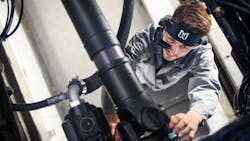Augmented reality gives assist to vehicle maintenance shops
Editor's Note: This is Part One of a two-part-story. Read Part 2 HERE.
Managing and operating a commercial vehicle repair shop can feel like a juggling act where there are too many balls and never enough hands, literally due to the lack of labor. And the problems range from A to Z—aftertreatment to zero emissions.
However, maintenance teams don’t need to face these issues on their own, help is here in the form of augmented reality (AR). Currently, shops have several ways to access the productivity-boosting technology, from smartphones and tablets to sophisticated wearable computers. Applications running on these devices can extend shops an extra hand by enhancing a worker’s environment with contextual visual data. This can be as simple as work instructions and as complex as a holographic brake assembly. And when that is not enough, the wearable devices, using WiFi, Bluetooth, or 4G, can call an expert who sees what the tech sees and provide guidance.
Read more: AR tools continue to be adopted for vehicle maintenance
Several maintenance operations, mostly at the dealer level, have already found the benefits of their workers using the new data and remote expertise provided by these tools to diagnose issues and complete repairs faster.
“I think it won’t be long before everyone realizes that if they don’t have their shop outfitted or their technicians connected, they’re going to be at a significant disadvantage,” said Andrew Chrostowski, chairman and CEO of RealWear, which makes industrial wearable headsets. “They’re going to be less productive, perhaps working less safely.”
RealWear’s HMT-1 ruggedized wearables, launched in 2018, have already found their way into all Ford dealerships to offer high-tech help in the bay, the CEO said.
Read more: Ford Technical Assistance Center using TeamViewer AR solution to support service technicians
And the cost of adoption has come down while the technology, and wireless connectivity in the shop, have improved.
“The device cost thresholds are now at the same place of ruggedized tablets of any kind,” Chrostowski noted. “Connectivity is ubiquitous; it’s not like you can’t afford internet at your shop.”
The goal is always to perform better quality work in a shorter amount of time. And that’s what Peterbilt has apparently achieved with its proprietary ARTech to help with electrical maintenance and troubleshooting. The software tool re-conceptualizes 2D technical information (wiring diagrams) as full-scale 3D objects created from CAD models. Technicians can point their iPad’s camera at a Model 579, for example, and ARTech populates the screen with dozens of colorful lines weaving around the image representing the flow of wiring.
As of Spring 2022, Peterbilt deployed 200 of the AR tools throughout its dealership network.
“Instead of having to carry a laptop, an adapter, and other tools to be able to pull information up on a laptop, now you’re carrying an iPad with all of the information in one convenient location,” said Mike Lacey, western regional product support manager at Ohio Peterbilt, last year. “This has been a huge timesaver in pinpointing and troubleshooting codes and issues, speeding up the process, and getting our customers’ trucks back on the road as quickly as possible.”
So far, the results have been promising.
“We have anecdotal information of [technicians] being able to save anywhere from 15 to 30 minutes on an electrical repair,” noted David Yin, product manager for ARTech at Peterbilt. “Now, I have heard a handful of cases where it’s saved them over eight hours, simply because you’re trying to break down and communicate where certain things are, but you can’t see it.”
And this is just the beginning. What would have seemed like science fiction when many managers first stepped foot in the bay is now poised to elevate the industry in a big way.
In Part 2 we will cover repeatable use cases employing augmented reality devices. And for a detailed explanation of AR's various forms, click here.
About the Author

Alex Keenan
Alex Keenan is an Associate Editor for Fleet Maintenance magazine. She has written on a variety of topics for the past several years and recently joined the transportation industry, reviewing content covering technician challenges and breaking industry news. She holds a bachelor's degree in English from Colorado State University in Fort Collins, Colorado.

